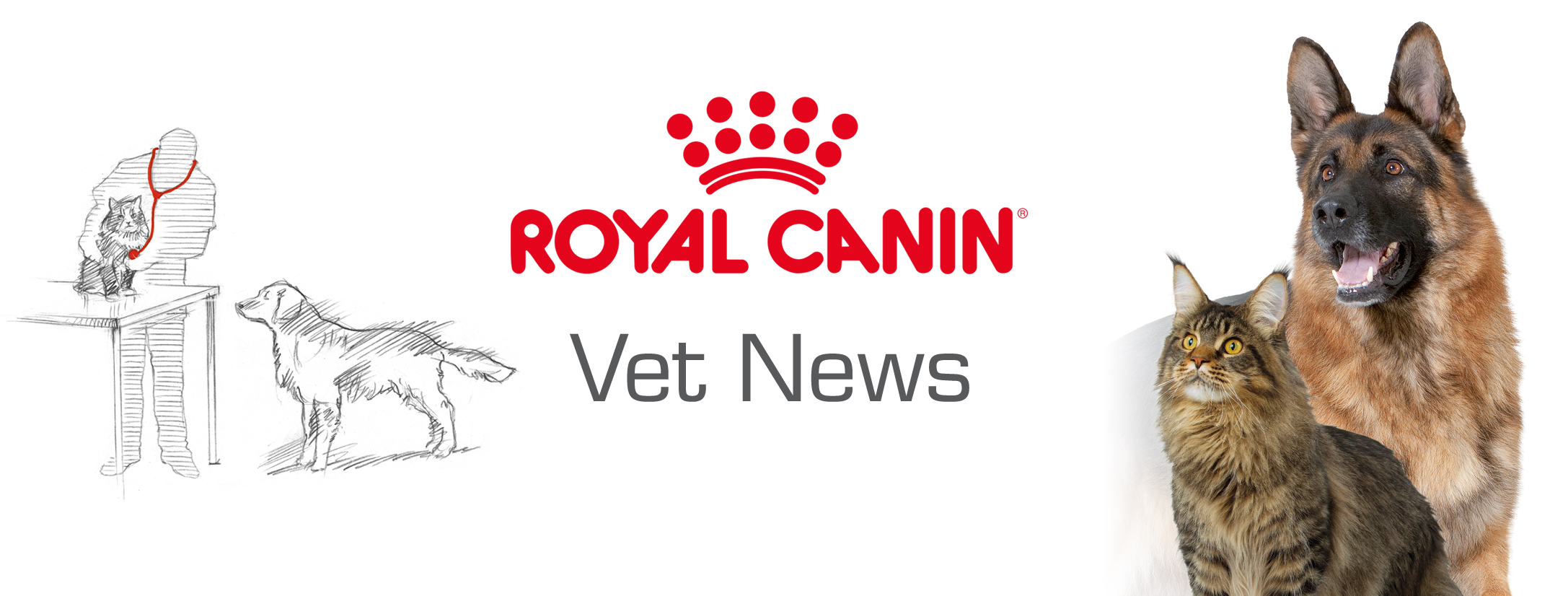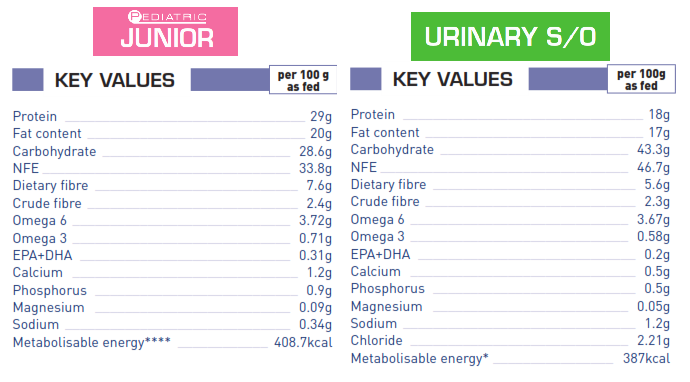
What to feed when your clinical cases are in growth
Pip is a five month old Cocker Spaniel. As expected, she’s one to bound about the park, get into mischief, explore the world on walks and lives most of her life in the great outdoors. When lead-walking about town with her owner she’s noted to go beyond the normal levels of wanting to stop at every corner, shrub, pole or post-box, instead actively squatting and urinating, sometimes even before having a good sniff. Pip’s owner recognises that recently she is ‘not quite herself’ in other ways, somewhat dismissing her food and proving to be a little less pleased when playing with the other dogs she met in puppy class. With these clues, your astute owner pops into the local homeware store to grab a jar, which now houses the urine sample that sits before you on the consult room table.
You’re going through your pattern recognition process on what is quite clearly a urinary case and the yellow sample in front of you is of course the best starting point. You can see immediately that the sample is cloudier than you’d expect. Having been refrigerated, you wait for the sample to come to room temperature before doing anything but realise that it has limited value given that it was collected on yesterday’s walk. It’s reported that 92% of samples precipitate crystals after 24-hours and that ideally we should have a sample on the slide at most 60 minutes after voiding(1). Armed with a new pot, your owner pops out for a walk around the block.
End result is that Pip has a urine specific gravity of 1.050 and a pH with high levels of protein and blood on dipstick. Under the microscope the sample is hooching with the coffin-lid struvite crystals we’re all used to seeing. With a slightly increased temperature and given her ‘unwell-ness’, you’re pretty convinced we’ve got a UTI here, alongside the crystalluria, and indeed it’s probably the urease-producing bacteria that are responsible for most of the urine abnormalities. While you mull-over antibiotics, your receptionist asks ‘should I put a bag of Urinary on the account?’ which makes you mull even more.
The immediate response to the receptionist is ‘yes’, but this gets caught in your throat as you glance at the patient record, reminding yourself that Pip is only 5 months old. Flicking through the product details you see that the urinary diet you’d normally choose is contraindicated in growth. It’s a conundrum.
This is a very common occurrence of course. Our younger patients are often the ones suffering conditions associated with infectious agents, misadventure and dietary indiscretion, however sometimes we’re frustrated to find ‘not suitable in pregnancy, lactation and growth’ staring at us from the product book page of our preferred diet. ‘Why can’t you feed this to puppies?’ you hear the nurse who is now on the phone to the helpline asking. You’ve often wanted the finer details yourself.
While a puppy or kitten can of course survive when fed a generic adult formula, we have now a plethora of studies which suggest that we can achieve optimal health by feeding a more bespoke product for the growing individual. So detailed are some of these studies that now we can refine what we feed according to predicted adult bodyweight and even breed. This is a founding concept behind size health nutrition.
A growth formula has adapted caloric density, protein composition and levels, calcium and phosphorus levels, antioxidants and many other micronutrients (vitamins and minerals) in order to support the developing body. In particular, the musculoskeletal and gastrointestinal systems (as well as the developing immunity) can be positively influenced by means of what goes in the food bowl. If you put the dietary analysis of a growth product alongside that of an adult one you will easily witness significant differences and start to appreciate the more subtle ones too. Compare a growth to a urinary diet (figure 1) and the differences are even more remarkable.
One example is the obvious difference in protein requirements for the growing dog. The European Pet Food Industry’s nutritional guidelines (FEDIAF) tell us that in Pip’s case (late growth: >14weeks), a minimum 50g of diet should be delivered to her per 1,000 kilocalories of diet (figure 2(4)). When we go ahead and calculate her energy requirement, once again according to FEDIAF formulas, we see that Pip, currently at 8kg and an estimated 60% her adult weight(5), requires about 840 kCal per day(4). The amount of protein delivered by a ration which includes this amount of energy from urinary food is 39 grams, falling significantly short of her requirements at this sensitive time in development. However, when fed an appropriate ration from a bag of junior food, close to 57 grams of protein will be consumed per day – much more in keeping with her age-range and breed’s weight requirements.
This factor and many more relating to optimal nutrient supply are taken into account when formulating a growth diet. The unfortunate truth is that a Urinary diet, with a host of other nutritional priorities, does not. In many ways (because a urinary diet is so unique in many aspects, including its micronutrient profile) an ideal urinary formula will never deliver the requirements for growth.
Armed with this understanding of the finer detail we can now appreciate the ‘not indicated for growth’ claim, and really resist the temptation to tell our owners to bend the rules, feed the clinical diet and maybe just increase the amount of food you put in Pip’s bowl every day. When it comes to supporting a patient showing a clinical condition during their growth period (up to 12 months of age in Pip’s case, being a medium-sized breed) we need to be adaptable in our recommendations, and conduct a risk-benefit analysis based upon helping ameliorate immediate clinical signs and the medium and long-term impacts of feeding in an ‘off-label’ manner.
To summarise, while some of the skin and GI diets are thankfully balanced for growth, the urinary product is not. On advice from the helpline and knowing that a strong priority in both crystalluia and UTI cases is to flush that lower tract with as much water-turnover as possible (ideally achieving a USG of 1.020 or less)(6), you highlight to Pip’s owner the things that can be done to help alongside an insistence that she be maintained on a long course of antibiotics (well beyond a clear UA). Pip is thankfully a good drinker, but her active and ‘dog about town’ lifestyle probably doesn’t give her as much opportunity to drink as she should do, particularly given the amount of exercise she takes. From now on there will be a water bowl provided wherever she stops, alongside new bowls in the kitchen, the garage and on the first floor landing and porch. We’ll experiment with soaking the kibbles in a little water before feeding and other patients have had success with ice-cubes as a novel ‘treat’.
Now… let’s await those urine sample results from the lab and be sure to book Pip in for a visit the week after next.

References/further reading:
- Albasan, H. Lulich, J. Osborne, C. Lekcharoensuk, C. Urlich L. & Carpenter, K. (2003) Effects of storage time and temperature on pH, specific gravity, and crystal formation in urine samples from dogs and cats, Journal of the American Veterinary Medical Association, 2003 Jan 15:222(2): 176-9.
- Caney, S. Cortadellas, O. Dhumeaux, M. & Nickel, R. (2014) Veterinary Focus Special Edition: Practical Management of Urinary Tract Disease, Aimargues, Royal Canin.
- Elliott, D. (2012) Nutritional considerations for optimal puppy growth, Veterinary Focus 22:2; 2-8.
- FEDIAF: The European Pet Food Industry Federation (2013) Nutritional Guidelines For Complete and Complimentary Pet Food for Cats and Dogs, Available at: http://www.fediaf.org/fileadmin/user_upload/PetNutrition/FEDIAF_Nutrtion_Guideline161214.pdf [accessed 9th May 2015]
- Hawthorne, A. Booles, P. Nugent, P. Gettinby, G. & Wilkinson, J. (2004) Body-Weight Changes during Growth in Puppies of Different Breeds, The Journal of Nutrition, 2004 Aug 134:8: 2027S-2030S.
- Koehler, L. Osborne, C. Buettner, M. Lulich, J. & Behnke, R. (2015) Canine Uroliths: Frequently Asked Questions and Their Answers [Online] , Available at: http://www.cvm.umn.edu/depts/minnesotaurolithcenter/prod/groups/cvm/@pub/@cvm/@urolith/documents/asset/cvm_asset_388871.pdf [accessed 9th May 2015]